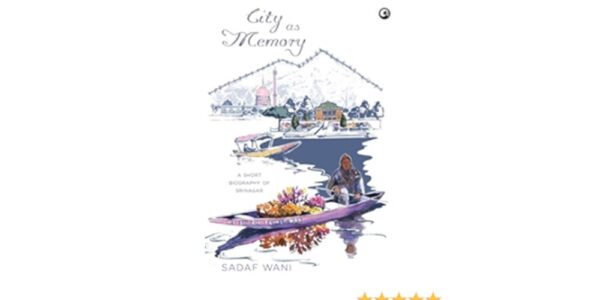Review of Sadaf Wani’s City as Memory: A Short Biography of Srinagar
Sadaf Wani is a Kashmiri writer and a senior communications professional authored her latest book, City as Memory: A Short Biography of Srinagar. In this book, she draws on her childhood experiences of the mid-90s, captivated by unrestrained insurgencies, upheavals, and augmenting militarization, and the early 2000s, soaked with a series of violent acts in response to civil protests. Wani shares the reminiscences of her personal acquaintances with the locality and the serious scholarship of Srinagar, as well as the insight stories of the people living in Kashmir.
In the book, Wani tells about a graveyard, the Malkha graveyard, where her great-grandmother was laid next to her husband. While searching her great-grandmother graveyard, she found before her a magnificent view of Haer Parbat (also known as the Koj-i-Maran), crowned by the Haer Parbat Fort. This strategic position provides a clear 360-degree view of the city. It was on this Fort Akbar carried out his first architectural intervention in Kashmir in the sixteenth century, marking his administrative centre, the city of Nagar Nagar, by fortifying the area around the hill. Ata Mohammad Kha Barakzai of the Durrani Empire built the fort, which currently rests on the hill. Whenever rules changed, their insignia on the fort changed as well. At present, the Indian flag stands hoisted on the fort, as she adds further.
Another interesting story Wani tells about her meeting with Dr. Rashid Maqbool at the University of Kashmir. While talking, Maqbool interjected her in Kashmiri and told her, “Before we move any further, I must point out that you are pronouncing the name wrong. It is not Srinagar; there is no sri sound in Kashmiri. It’s pronounced Sirinagar.”
* Click to Follow Voice of Ladakh on WhatsApp *
Wani further draws on her horrific experiences and adds that by 1988, many democratic reforms initiated by the government were rolled back, leading to widespread discontent and public distrust regarding the intentions of the government in their policies towards Kashmir. She writes, Downtown, like the rest of Kashmir, was completely transformed by jolting political and socio-cultural changes that took place within a few years from 1989… the first show of guns in public, the proclamation of Kashmir’s revolt through the Tehreek, the establishment of the separatist leadership, the crumbling of state order, and so on were unfolded in the streets of Downtown.
Wani remembered that in 1990, Kashmir had a documented record of hundreds of unarmed civilians being fired upon by the security forces; there were widespread arrests. Wani sees that even on the days there were no raids, fear dominated the public mind.
Wani mentions in the book that after 2008, the term ‘Downtown’ began to supplant ‘Old City’ and ‘Shahr-e-Khas’ in both local vernacular and media reports. At another point, while talking about beautiful gardens, she told After the Mughal rule, there was a considerable decline in the administrative use of gardens, and the successive Afghan, Sikh, and early Dogra rulers didn’t pay much attention to their maintenance. It was during the Dogra reign in Kashmir that the region’s culture of gardens was resuscitated with the establishment of the British Residency. It was because of their alliance with the Dogra Kings that the British officials looked favourably on Kashmir and popularised the idea of Kashmir as a summer retreat.
The city, with its gardens and lakes, was being transformed to cater to the influx of foreign visitors who sought refuge from the scorching summer temperatures on the plains. Different areas of the city were preferred by different ruling regimes, but due to strategic and military avail of the area around the Haer Parbat, which allows a panoramic view of the city and easy access to the waterway network via the Dal Lake, Nigeen Lake, and Jhelum, this part of Srinagar found favour with almost all regimes that have ruled over Kashmir.
This book is a must-read. It includes all the vivid things about Kashmir in the 1990s and hereafter that a person faced during that moment. Sadaf Wani elucidates everything lucidly about the situation at that time, including how fear was ingrained in people’s minds and how it changed the dynamics of society and their living approach after having experienced the upheaval in every moment that had a huge impact on people’s lives. This short biography of Srinagar subtly describes it.



0 Comments